LP is 2.7 meters from the speakers, base is 3.2 meters wide. Slight toe in of 10 degrees. There is no treatment appart from a deep-pile rug and furniture.
I cannot confirm this. The center is rock solid and I could even extend the base if the room would allow it, without a relevant loss of phantom center quality (sadly, there is a door provibiting it). I have not experienced hazyness at all, only a dimishing of imaging when the speakers were not toed in and early reflections from the side wall increased.
Sitting closer does increase envelopment, but I dont mind the clarity of almost pure direct sound. Further, I assume the increased envelopment is a result of the changed relation LP <-> speaker distance / base width, making the the stereo angle shorter, virtually increasing base width.
Hi, yeah when in the close proximity you can adjust for nice "stage" by positioning speakers to suitable base width, at which angle they are to you. Distance from speaker to ear is about irrelevant now, as long as you are on the design plane and so on, far field of the speaker. Or perhaps not, perhaps the envelopment can now be tuned by adjusting early reflections so speaker position matters at least some (other than just frequency response through interference).
If you check Griesinger papers what the transition is, it is that brain ability to lock in to the close sound that needs attention. The lock in mechanism works on harmonics. His work is mostly around live acoustic sound but if thinking in loudspeaker context original sound harmonics are mingled by the room (reflections) like in live, but could also be from bad frequency response or group delay, perhaps other things like edge diffraction and lobing for example.
With phantom center sound we already have two sources at least and any interference can easily ruin it. When phantom center is extremely sharp you can be sure brain tracks it, speakers are fine enough and room noise is low enough so brain locks in. Of course phantom center is audible also from further away and with many kinds of speaker qualities, its just not as defined, no precise location but hazier ball somewhere between speakers or something, I do not know how to describe correctly 😀 Subtle, but noticeable after you find the transition.
Here is why it is important: being able to lock in means full attention, basically brain separates the important direct sound from all background noise so to speak. Griesinger refers to coctail party effect where you can concentrate voluntarily up to four different person talking amid all the talking that happens in the room. You'd immediately hear and even localize if someone mentions your name for example. He also writes and talks about importance of this in education, in class rooms and auditoriums and how the attention is must for memorizing and learning. Overall, the hearing mechanism feels very important thing.
I'm speculating that in loudspeaker context it works as well, allows engagement and all that, max emotional impact. If Griesinger work is true, and if what I hear with my setup is what he talks about and not just some quirk I think it should be common for others as well, identified by finding the transition. It is prequisite for best possible sound that has emotional impact and so on, grabs attention fully.
From all this I reason that the max listening distance needs to be identified, and then adjust the situation to liking. I haven't played with this too much yet, but for example wesayso has ambient speakers to manipulate the background, if direct sound is too heavy to listen to then additional roo. sound enhancement could help it. Or just listen at the far, less accurate sound if it feels more comfortable. Hearing the transition is key I think, to recognize either sound and then be able to work with it.
ps.sorry writing so much on it for this thread. I'm tryibg to pick the subject up when ever possible, trying to get others to write their experiences as I don't have local hobbyists I could share this with 🙂 So, thanks sheeple for responding!
Last edited:
Well I hear it, but at my couch. When I want to be absorbed in the music, literary taken over by the music stream, sucked up into the music, I close my eyes and lean a bit forward on said couch. If I want to relax, and not be as absorbed by the music, I can sit back on that same couch and still enjoy what I get, but it's a little less immediate and/or attention grabbing. Leaning more forward, I get an impulse at the listening position that looks like this:

The timing of that impulse, as measured at the listening position looks like this in a wavelet:

In my IR you see no obvious large peaks from early reflections, as I've placed absorption at all first reflection points, observing the indirect sound I had at the listening spot to determine the thickness needed for the panels. The room isn't dead by any means. There's more than enough liveliness to make it a fully functional living room.
I still do have reflections, arriving at the listening spot from lateral angles (uncorrelated and specifically timed). In other words: a Haas kicker coming in at about ~20 ms after the main pulse. This gives me all the focus and attention grabbing direct sound plus envelopment and spaciousness that comes from the recording. Still sounding perfectly natural. It truly differs from recording to recording in size and shape. Much of that envelopment is originating from low frequencies starting below about 400 Hz (so keep that bass output stereo if you love that stuff 😉).
This room/speaker setup is ideal for Pop, Rock, Jazz, basically every recording created in the Studio. For Classical music, all I would change is to get the Haas kicker in a little earlier (say at about 10 ms). Makes it that much more convincing and a little less focused.
The above situation is not comparable to having earlier room reflections (somewhere in the first 6-15 ms), even if that does seem to alter the feel of space, in contrast to the Haas kicker, it puts the same space over every recording you play (just like @camplo said). I know quite well how that sounds, as I've had that too 🙂. All I'd need to get back to that sound is to take down the panels I have, 3 (big ones) in total to get that result again. It results in a more fuzzy and hazy imaging, a presentation that puts the recording in my room and has about the same properties/size no matter the recording or song played. It doesn't change with the song that is played.
My speakers have a rising DI, and with the ambience channels helping out (which is my synthesized Haas Kicker) it creates a perfectly natural sound anywhere in the room. I think most people still underestimate the influence of the room itself on what they hear/perceive. You can have the best speakers you can come up with, but if your room doesn't carry the sound well enough, you'd still be disappointed with the final results. That's why I manipulated my room, which is kind of small, to make it sound like a bigger, better "space". (easier to do than to make a large space sound small 😀)
All I'm saying is: you can have the cake and eat it too. Awesome attention grabbing sound, presented with clarity, great tonality and dynamics plus envelopment and spaciousness (as long as it's present in the recording). If that sounds intriguing, just look up that other key figure at Harman (the man behind the Lexicon reverbs) who has been on this crusade of figuring out the psycho-acoustic part of hearing for far longer and deeper, Mr. David Griesinger. I don't regret the time spend reading both Toole and Griesinger. But for rooms and it's effect on our perception? I'd go for the teachings of Griesinger, every time. While lots of his material is about perception of music in halls etc, it's still quite worth the read for things like the proximity effect etc. It's a far better explanation than saying: we are used to hearing the room, so we don't mind it while listening to our speakers. Our brain will filter it out.
I say: Take out that room, and let the music take over! 🙂
{end of rant, sorry for the derail}
The timing of that impulse, as measured at the listening position looks like this in a wavelet:
In my IR you see no obvious large peaks from early reflections, as I've placed absorption at all first reflection points, observing the indirect sound I had at the listening spot to determine the thickness needed for the panels. The room isn't dead by any means. There's more than enough liveliness to make it a fully functional living room.
I still do have reflections, arriving at the listening spot from lateral angles (uncorrelated and specifically timed). In other words: a Haas kicker coming in at about ~20 ms after the main pulse. This gives me all the focus and attention grabbing direct sound plus envelopment and spaciousness that comes from the recording. Still sounding perfectly natural. It truly differs from recording to recording in size and shape. Much of that envelopment is originating from low frequencies starting below about 400 Hz (so keep that bass output stereo if you love that stuff 😉).
This room/speaker setup is ideal for Pop, Rock, Jazz, basically every recording created in the Studio. For Classical music, all I would change is to get the Haas kicker in a little earlier (say at about 10 ms). Makes it that much more convincing and a little less focused.
The above situation is not comparable to having earlier room reflections (somewhere in the first 6-15 ms), even if that does seem to alter the feel of space, in contrast to the Haas kicker, it puts the same space over every recording you play (just like @camplo said). I know quite well how that sounds, as I've had that too 🙂. All I'd need to get back to that sound is to take down the panels I have, 3 (big ones) in total to get that result again. It results in a more fuzzy and hazy imaging, a presentation that puts the recording in my room and has about the same properties/size no matter the recording or song played. It doesn't change with the song that is played.
My speakers have a rising DI, and with the ambience channels helping out (which is my synthesized Haas Kicker) it creates a perfectly natural sound anywhere in the room. I think most people still underestimate the influence of the room itself on what they hear/perceive. You can have the best speakers you can come up with, but if your room doesn't carry the sound well enough, you'd still be disappointed with the final results. That's why I manipulated my room, which is kind of small, to make it sound like a bigger, better "space". (easier to do than to make a large space sound small 😀)
All I'm saying is: you can have the cake and eat it too. Awesome attention grabbing sound, presented with clarity, great tonality and dynamics plus envelopment and spaciousness (as long as it's present in the recording). If that sounds intriguing, just look up that other key figure at Harman (the man behind the Lexicon reverbs) who has been on this crusade of figuring out the psycho-acoustic part of hearing for far longer and deeper, Mr. David Griesinger. I don't regret the time spend reading both Toole and Griesinger. But for rooms and it's effect on our perception? I'd go for the teachings of Griesinger, every time. While lots of his material is about perception of music in halls etc, it's still quite worth the read for things like the proximity effect etc. It's a far better explanation than saying: we are used to hearing the room, so we don't mind it while listening to our speakers. Our brain will filter it out.
I say: Take out that room, and let the music take over! 🙂
{end of rant, sorry for the derail}
I used ATH to simulate a freestanding horn over an enclosure to create FRD files that can be imported into VituixCAD to simulate crossovers. @VoxCelestial helped me learn how to measure a freestanding horn (waveguide) over a simple box enclosure. Consequently, I tried to use ATH to model and simulate a freestanding waveguide over a simple box enclosure. I couldn't figure out how to place a real woofer into a simple box so I increased the ATH default compression driver diaphragm instead and reduce the horn length to 10mm.
After simulating the waveguide and enclosure separately (consistent with how I'd measure them separately in real life) I exported the resulting FRD files then imported them into VituixCAD so I could simulate crossovers. My main goal at present is to learn how to match the directivity between a waveguide and an enclosure so I generated several different waveguide diameters to try inside VituixCAD against the 9 inch enclosure box. I like the idea of simulating the waveguides separately from the enclosure because you can adjust center to center distance and z axis inside VituixCAD. It may or may not be good practice to simulated them in ABEC together once you settle on a final design. However, I don't think you'd measure them together in real life for import into VituixCAD so simulating them together may be unnecessary.
I'm including the configuration file I used for the enclosure and an 8 inch (20 cm) driver but don't copy my method because it's almost certainly the wrong way to do it.

I created a separate ATH config file for the horn section. I did not place the center of rotation at the acoustic center of the horn because I still need to learn how to do that. For the sake of expediency I used the baffle surface of the horn (horn length) so I could create simulations.
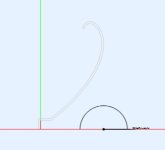
Here's the ATH configuration file for the horn. I will also include five additional waveguide diameters and directivity indexes I simulated vs the 9 inch enclosure box in the attached Zip file.
Running the ATH report ("-r") like normal generates the FRD files that can be copied over to your VituixCAD folders then imported into VituixCAD for crossover simulation.
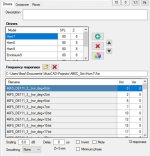
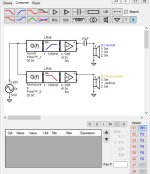
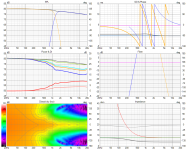
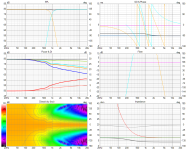
You'll notice the SPL is at 80dB even though the amplifiers are at 0dB. That's because I set them to 80dB in the Optimizer window when I created the transfer files. In this case, I used the Optimizer window to set "D1 Horn9" (9 inch diameter horn) to a -1/dB octave tilt, down sloping over the full bandwidth of the compression driver/horn. Setting the SPL to 80dB here carries over to your simulations. If you set it to zero in Optimizer or didn't use Optimizer at all you'd have to adjust your power amplifiers to increase SPL.
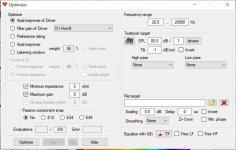
I'll include all the files I used to make these simulations in the VituixCAD and ATH Configs Zip attachments. Just remember I didn't do it exactly right: 1) horn rotation not set at acoustic center, 2) a compression driver diaphragm rather than a woofer diaphragm, and 3) probably several other mistakes I'm not aware of yet. I also included instructions written by Reid Towsley for working with the G(f) block and exporting transfer function files into Equalizer APO in the VituixCAD Zip.
After simulating the waveguide and enclosure separately (consistent with how I'd measure them separately in real life) I exported the resulting FRD files then imported them into VituixCAD so I could simulate crossovers. My main goal at present is to learn how to match the directivity between a waveguide and an enclosure so I generated several different waveguide diameters to try inside VituixCAD against the 9 inch enclosure box. I like the idea of simulating the waveguides separately from the enclosure because you can adjust center to center distance and z axis inside VituixCAD. It may or may not be good practice to simulated them in ABEC together once you settle on a final design. However, I don't think you'd measure them together in real life for import into VituixCAD so simulating them together may be unnecessary.
I'm including the configuration file I used for the enclosure and an 8 inch (20 cm) driver but don't copy my method because it's almost certainly the wrong way to do it.

Throat.Diameter = 158 ; 6.2 inches (diapraghm diameter of 8 inch driver)
Throat.Angle = 10
Coverage.Angle = 10
Length = 1
Term.s = 1
Term.n = 1
OS.k = 1
Term.q = 1
Report = {
PolarData = SPL_H
Title = "Enclosure"
}
box = {
point P0 114 0 50
point P1 114 228 50
point PB 0 228 50
line P0 P1
line P1 PB
}
Mesh.Enclosure = {
Plan = box
Spacing = 0,35,0,35 ; left, top, right, bottom
}
Mesh.VerticalOffset = 0
Mesh.Quadrants = 14 ; 14 = 1/2 symmetry ; 1 = 1/4 symmetry
Mesh.LengthSegments = 12
Mesh.AngularSegments = 12
Mesh.ThroatResolution = 50
Mesh.MouthResolution = 50
Mesh.SubdomainSlices =
ABEC.SimType = 2 ; free space
ABEC.MeshFrequency = 1000
ABEC.NumFrequencies = 100
ABEC.f1 = 20
ABEC.f2 = 20000
ABEC.Polars:SPL_H = {
MapAngleRange = 0,180,36
NormAngle = 0
Distance = 2.0
FRDExport = {
NamePrefix = hor
PhaseComp = -2.0 ;[m]
}
}
Output.ABECProject = 1
Output.STL = 0
I created a separate ATH config file for the horn section. I did not place the center of rotation at the acoustic center of the horn because I still need to learn how to do that. For the sake of expediency I used the baffle surface of the horn (horn length) so I could create simulations.

Here's the ATH configuration file for the horn. I will also include five additional waveguide diameters and directivity indexes I simulated vs the 9 inch enclosure box in the attached Zip file.
Throat.Ext.Angle = 0 ;
Throat.Ext.Length = 10.75;
Slot.Length = 0
R-OSSE = {
R = 101 ;
a = 46 ;
r0 = 9 ;
a0 = 23 ;
m = 0.76 ;
r = 0.30 ;
q = 3.65 ;
k = 18.6 ;
b = 0.0 ;
arcterm = 160 ;
}
Rot = 12 ;
Report = {
PolarData = SPL_H
Title = "DE111 - Horizontal"
}
Source.Shape = 1
; -------------------------------------------------------
; Mesh Settings
; -------------------------------------------------------
Mesh.LengthSegments = 64
Mesh.AngularSegments = 64
Mesh.SubdomainSlices =
Mesh.WallThickness = 2
; -------------------------------------------------------
; ABEC Project Settings
; -------------------------------------------------------
ABEC.SimType = 2 ; 2= Free Space, 1= Infinite Baffle
ABEC.SimProfile = 0 ; 0 = CircSym
ABEC.MeshFrequency = 33000
ABEC.NumFrequencies = 100
ABEC.f1 = 500 ; [Hz]
ABEC.f2 = 20000 ; [Hz]
ABEC.Abscissa = 1 ; 1=log | 2=linear
ABEC.Polars:SPL_H = {
MapAngleRange = 0,180,72
NormAngle = 0
Distance = 2.0
Offset = 65.06
FRDExport = {
NamePrefix = hor
PhaseComp = -2.0 ;[m]
}
}
; -------------------------------------------------------
; Output
; -------------------------------------------------------
Output.SubDir = ""
Output.STL = 0
Output.ABECProject = 1
Running the ATH report ("-r") like normal generates the FRD files that can be copied over to your VituixCAD folders then imported into VituixCAD for crossover simulation.




You'll notice the SPL is at 80dB even though the amplifiers are at 0dB. That's because I set them to 80dB in the Optimizer window when I created the transfer files. In this case, I used the Optimizer window to set "D1 Horn9" (9 inch diameter horn) to a -1/dB octave tilt, down sloping over the full bandwidth of the compression driver/horn. Setting the SPL to 80dB here carries over to your simulations. If you set it to zero in Optimizer or didn't use Optimizer at all you'd have to adjust your power amplifiers to increase SPL.

I'll include all the files I used to make these simulations in the VituixCAD and ATH Configs Zip attachments. Just remember I didn't do it exactly right: 1) horn rotation not set at acoustic center, 2) a compression driver diaphragm rather than a woofer diaphragm, and 3) probably several other mistakes I'm not aware of yet. I also included instructions written by Reid Towsley for working with the G(f) block and exporting transfer function files into Equalizer APO in the VituixCAD Zip.
Attachments
Last edited:
Realized I could have used the same process as modeling a dome tweeter to model the woofer. However, the difference between a real measured woofer and the ATH default horn diaphragm isn't too different. Good enough to at least get a general idea of how the enclosure will do. But you could model the woofer using ATH's "6.5 Modelling a complex source" instructions and examples.
Real measurement vs simple model (default ATH diaphragm) - 8 inch woofer in 9x9 inch enclosure
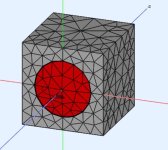
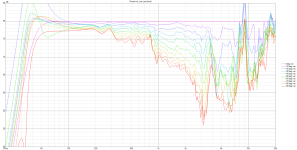
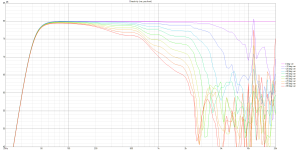
Real measurement vs simple model (default ATH diaphragm) - 8 inch woofer in 9x9 inch enclosure



Trying to learn directivity matching between waveguide and woofer so I attempted to model a freestanding R-OSSE with similar directivity to JBL 708P. I used the same enclosure size as the 708P but I moved the woofer to the top. (ATH configs and VituixCAD project attached in Zip files)
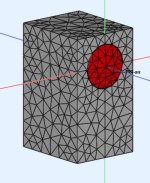
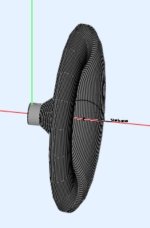
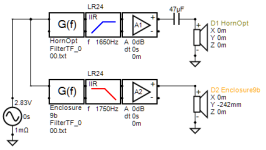
The ERDI bump can be reduced by increasing center-to-center distance between the waveguide and woofer from -242 to -322 (comes at expense of reducing vertical polar listening angles by 5 degrees). JBL 708P crossover is listed as 1.7kHz. I used the same frequency with a LR24 but that can be adjusted to make improvements as well. I did not experiment with moving the waveguide on the Z axis. And I did not rotate the waveguide around the acoustic axis during simulation (ABEC.Polars Offset).
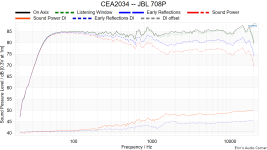
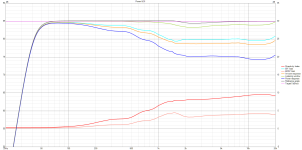
Horizontal Line
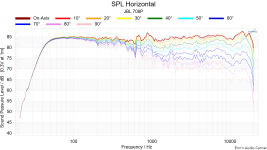
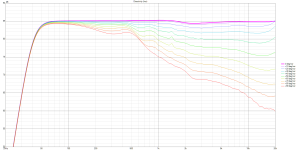
Horizonal Polars, non-normalized
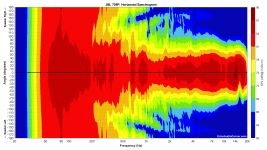
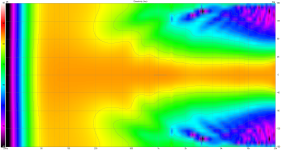
Vertical Polars - non-normalized
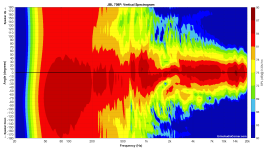
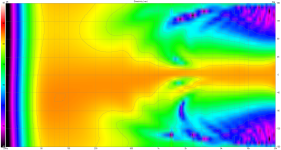



The ERDI bump can be reduced by increasing center-to-center distance between the waveguide and woofer from -242 to -322 (comes at expense of reducing vertical polar listening angles by 5 degrees). JBL 708P crossover is listed as 1.7kHz. I used the same frequency with a LR24 but that can be adjusted to make improvements as well. I did not experiment with moving the waveguide on the Z axis. And I did not rotate the waveguide around the acoustic axis during simulation (ABEC.Polars Offset).


Horizontal Line


Horizonal Polars, non-normalized


Vertical Polars - non-normalized


Attachments
Last edited:
Hi sheeple,LP is 2.7 meters from the speakers, base is 3.2 meters wide. Slight toe in of 10 degrees.
did quick test without toe-in; I think the sound never gets close and is always the blurry one in my setup, no envelopment, sound only in front although "big" in a way, but its my room and not the recording that I hear. I've also got "normal" living room with furnishing, no acoustic treatment, I assume its roughly similar listening situation as you have.
Have you tried proper toe-in, like 45 deg so that you are similarly off-axis but the speakers axis cross front of you instead of behind you? Or 30deg toe in to point to the ears directly? If you have, please share your thoughts, thanks!🙂 This is what I have, toed in to roughly on axis to maximize direct sound to extend the transition as far into the room as possible. This makes time intensity trading happen so sound stays pretty much between speakers through out the room, and as such it feels smaller than without toe-in. I can understand why one would prefer it.
I'm interested in this if you can get the Griesinger transition happen now with the toed in setup. Point of the transition is that when you get enough direct sound for brain to lock in you should be able to achieve better sound in general, better engagement and bigger in all dimensions than what you have now (or what I suspect you might have). Oh well the size now depends on whats on the recording rather than everything being the room size. I'm interested if you can make it happen, or not, in general whats your thought on it. Its fine if you don't have time to play with it 🙂 Thanks big time if you do!🙂
ps. With the toe-in you probably need to adjust the base width too, to your liking.
Last edited:
If this is real stuff I experience here and what Griesinger writes about is real and also applies with stereo systems, then its very important stuff in loudspeaker concept, not just concert halls and live sound. First of all anyone should know which sound they like to be able to then optimize the system for it. Optimization includes physical structure of the system, what the target responses are and so on. For example, listening on the far field I think on-axis sound has far less importance than SP and PIR for example, but if one is on the close sound the direct sound should be optimized over the power response. Preferably both, because we listen in both environments now, the close sound when at sweet spot and the far sound anywhere else in the premises.
Listening/preferring the far sound one probably benefits low DI system so that frequency response is pretty much the same to all directions because its not good anywhere (harshly saying) so at least it should be uniform to get any benefits. Definitely beaming would be a no no. Accuracy of phantom center never happens here anyway, so its all more or less loosely defined and various systems ought to work just fine. Phase linearization with FIR, perhaps not audible because the brain doesn't lock in it means harmonics are a mess due to room already, can't fix it with FIR. Diffraction probably doesn't matter much either. If this is the Griesinger stuff, engagement never happens, brain never pays attention to the sound. We hear it, but its just sound coming somewhere from the speakers direction but to hearing system its just background noise 🙂
If one fancies the close sound then everything matters, perhaps group delay audible and so on, as now brain hears the direct sound and room sound separately as foreground and background streams according to Griesinger. Brain involuntarily pays attention to the close direct sound, gets sucked in and engaged, and is able to separate the local room from what comes out from the speakers, the local environment more or less disappears. Here higher DI system probably works better as it should extend the maximum listening distance from really near field to something practical like 2-3meters out.
Understanding properly there is two distinct "sounds" would reduce unnecessary debate and so on, increase understanding in general. Its nice the transition seems so distinct and relatively easy hear as long as the listening setup allows it to happen. After hearing the transition its now much easier to understand about peoples perspectives and writings and situations, identify both sounds and why would some other speaker system or treat be preferred by others while someone else prefers something else.
I'm not sure if everyone can hear any difference or if this is real stuff or just an anomaly with my system, but it seems to me that it is real though, highly repeatable 🙂
I'm having ~typical living room situation, a room that is not optimized for audio in any way but has some typical living room furnishing, typical ceiling height and so on.
Listening/preferring the far sound one probably benefits low DI system so that frequency response is pretty much the same to all directions because its not good anywhere (harshly saying) so at least it should be uniform to get any benefits. Definitely beaming would be a no no. Accuracy of phantom center never happens here anyway, so its all more or less loosely defined and various systems ought to work just fine. Phase linearization with FIR, perhaps not audible because the brain doesn't lock in it means harmonics are a mess due to room already, can't fix it with FIR. Diffraction probably doesn't matter much either. If this is the Griesinger stuff, engagement never happens, brain never pays attention to the sound. We hear it, but its just sound coming somewhere from the speakers direction but to hearing system its just background noise 🙂
If one fancies the close sound then everything matters, perhaps group delay audible and so on, as now brain hears the direct sound and room sound separately as foreground and background streams according to Griesinger. Brain involuntarily pays attention to the close direct sound, gets sucked in and engaged, and is able to separate the local room from what comes out from the speakers, the local environment more or less disappears. Here higher DI system probably works better as it should extend the maximum listening distance from really near field to something practical like 2-3meters out.
Understanding properly there is two distinct "sounds" would reduce unnecessary debate and so on, increase understanding in general. Its nice the transition seems so distinct and relatively easy hear as long as the listening setup allows it to happen. After hearing the transition its now much easier to understand about peoples perspectives and writings and situations, identify both sounds and why would some other speaker system or treat be preferred by others while someone else prefers something else.
I'm not sure if everyone can hear any difference or if this is real stuff or just an anomaly with my system, but it seems to me that it is real though, highly repeatable 🙂
I'm having ~typical living room situation, a room that is not optimized for audio in any way but has some typical living room furnishing, typical ceiling height and so on.
Last edited:
That's one clean impulse!Well I hear it, but at my couch. When I want to be absorbed in the music, literary taken over by the music stream, sucked up into the music, I close my eyes and lean a bit forward on said couch. If I want to relax, and not be as absorbed by the music, I can sit back on that same couch and still enjoy what I get, but it's a little less immediate and/or attention grabbing. Leaning more forward, I get an impulse at the listening position that looks like this:
View attachment 1192979
The timing of that impulse, as measured at the listening position looks like this in a wavelet:
View attachment 1192986
In my IR you see no obvious large peaks from early reflections, as I've placed absorption at all first reflection points, observing the indirect sound I had at the listening spot to determine the thickness needed for the panels. The room isn't dead by any means. There's more than enough liveliness to make it a fully functional living room.
I still do have reflections, arriving at the listening spot from lateral angles (uncorrelated and specifically timed). In other words: a Haas kicker coming in at about ~20 ms after the main pulse. This gives me all the focus and attention grabbing direct sound plus envelopment and spaciousness that comes from the recording. Still sounding perfectly natural. It truly differs from recording to recording in size and shape. Much of that envelopment is originating from low frequencies starting below about 400 Hz (so keep that bass output stereo if you love that stuff 😉).
This room/speaker setup is ideal for Pop, Rock, Jazz, basically every recording created in the Studio. For Classical music, all I would change is to get the Haas kicker in a little earlier (say at about 10 ms). Makes it that much more convincing and a little less focused.
The above situation is not comparable to having earlier room reflections (somewhere in the first 6-15 ms), even if that does seem to alter the feel of space, in contrast to the Haas kicker, it puts the same space over every recording you play (just like @camplo said). I know quite well how that sounds, as I've had that too 🙂. All I'd need to get back to that sound is to take down the panels I have, 3 (big ones) in total to get that result again. It results in a more fuzzy and hazy imaging, a presentation that puts the recording in my room and has about the same properties/size no matter the recording or song played. It doesn't change with the song that is played.
My speakers have a rising DI, and with the ambience channels helping out (which is my synthesized Haas Kicker) it creates a perfectly natural sound anywhere in the room. I think most people still underestimate the influence of the room itself on what they hear/perceive. You can have the best speakers you can come up with, but if your room doesn't carry the sound well enough, you'd still be disappointed with the final results. That's why I manipulated my room, which is kind of small, to make it sound like a bigger, better "space". (easier to do than to make a large space sound small 😀)
All I'm saying is: you can have the cake and eat it too. Awesome attention grabbing sound, presented with clarity, great tonality and dynamics plus envelopment and spaciousness (as long as it's present in the recording). If that sounds intriguing, just look up that other key figure at Harman (the man behind the Lexicon reverbs) who has been on this crusade of figuring out the psycho-acoustic part of hearing for far longer and deeper, Mr. David Griesinger. I don't regret the time spend reading both Toole and Griesinger. But for rooms and it's effect on our perception? I'd go for the teachings of Griesinger, every time. While lots of his material is about perception of music in halls etc, it's still quite worth the read for things like the proximity effect etc. It's a far better explanation than saying: we are used to hearing the room, so we don't mind it while listening to our speakers. Our brain will filter it out.
I say: Take out that room, and let the music take over! 🙂
{end of rant, sorry for the derail}
Yes, sure, I started from this concept. I found the image to be too confined and I did miss room interaction. I don’t like it that way. Many recordings do not have enough spacial clues and will sound clinical. Yes, the image that I perceive with this setup also is in front of me, as in your case, but it is bigger and a bit more lively than with strong toe-in. I listen slightly off axis, with the axes crossing behind me and I am satisfied. But I am not hunting for extremes, as others do, and so might you.Have you tried proper toe-in, like 45 deg so that you are similarly off-axis but the speakers axis cross front of you instead of behind you?
My next step will be a wide waveguide. Actually, for a wide pattern speaker a smaller woofer would also be a better match, thinking from polar patter width and attainable crossover frequencies for the tweeter. But I doubt I will change to an 8-inch. One day, when I listened to a recording with extremely low voice volume, but a properly loud, electronic music jingle after the voice section ended, I learned what the woofer can do when it receives enough watts. My heart rate ... I think the 10-inches, to some degree, eliminate distortion issues not via a high-tech surround, but because they can handle a lot more SPL output than what I would want them to play.
Agreed he has done a great job of system optimization. No doubt it sounds good.That's one clean impulse!
- I've added a new waveguide to my website (type 460-36):
http://www.at-horns.eu/athex.html
https://a360.co/3DlzDxv
http://www.at-horns.eu/athex.html
https://a360.co/3DlzDxv
Yup, Griesinger.But for rooms and it's effect on our perception? I'd go for the teachings of Griesinger, every time. While lots of his material is about perception of music in halls etc, it's still quite worth the read for things like the proximity effect etc. It's a far better explanation than saying: we are used to hearing the room, so we don't mind it while listening to our speakers. Our brain will filter it out.

(..been saying that for about 2 decades.)
Those are the full beamwidths, so probably twice as wide as you may think. They are not so wide (see the DI)...
BTW, as I implemented the SPDI and ERDI quantities of the CEA2034, I only now realized how much are these forgiving. They are heavily averaged and hence diffraction-insensitive. If these curves are not smooth, something really bad must be happening...


BTW, as I implemented the SPDI and ERDI quantities of the CEA2034, I only now realized how much are these forgiving. They are heavily averaged and hence diffraction-insensitive. If these curves are not smooth, something really bad must be happening...
Last edited:
Could anyone sum up the basic idea in a few sentences? I read through some of the papers and all I can gather is that it's good to have a strong and clear direct sound, free of early reflections (i.e. to achieve as long time gap as practically possible). Isn't it exactly just what we are trying to do with big waveguides (and the toeing-in) all this time? But perhaps I haven't caught all of it.Yup, Griesinger.
(..been saying that for about 2 decades.)
Hi,
basic idea on Griesinger studies to me, in few centences is: hearing system is sensitive to harmonic series of any sound, and when phase relationship of a sound source harmonics is preserved brain thinks its important close sound, important for survival. Basically brain involuntarily pays attention to close sounds which makes it easy to understand and remember for example. When this happens there is two neural streams, foreground and background which I simplify to direct sound and envelopment basically. When phases are mingled, there is only one neural stream, basically the room sound.
His work is mostly on live sound and concert halls, auditoriums. Still, we carry the same hearing system at home as well so we could speculate same stuff applies to home hifi as well. Phase relationship of harmonics is mingled by room sound and likely by group delay and edge diffraction for example, why not distortion, compression and stuff like that.
I speculate this stuff can be listened at home: listen with small enough stereo triangle, like in a studio near field monitoring situation, and you have the phases preserved and very clear sound, very good imaging and envelopment and stuff. Basically one hears whats on the recording and not the local room. Make listening triangle too big and it all gets more blurry, no envelopment, basically sound is seemingly coming somewhere from speaker direction, this is just local room sound a hazy blob in comparison. Now, go and find the transition in between these two by listening. Distance where this happens seems to be very small and it seems to be on/off effect between the near and far sound, literally one step and the perception shifts, just like Griesinger describes in some papers. Assuming its the same/similar thing, then by Griesinger studies best sound is listened close enough. Distance whats close enough depends on multiple factors, room acoustics mostly, also speaker directivity and perhaps the other qualities. Some people do not like this, but instead prefer the more hazy sound.
Any papers of his basically revolve around this stuff. For example this short one http://www.ica2016.org.ar/ica2016proceedings/ica2016/ICA2016-0379.pdf or this one https://www.akutek.info/Papers/DG_Audibility_Direct_Sound.pdf
basic idea on Griesinger studies to me, in few centences is: hearing system is sensitive to harmonic series of any sound, and when phase relationship of a sound source harmonics is preserved brain thinks its important close sound, important for survival. Basically brain involuntarily pays attention to close sounds which makes it easy to understand and remember for example. When this happens there is two neural streams, foreground and background which I simplify to direct sound and envelopment basically. When phases are mingled, there is only one neural stream, basically the room sound.
His work is mostly on live sound and concert halls, auditoriums. Still, we carry the same hearing system at home as well so we could speculate same stuff applies to home hifi as well. Phase relationship of harmonics is mingled by room sound and likely by group delay and edge diffraction for example, why not distortion, compression and stuff like that.
I speculate this stuff can be listened at home: listen with small enough stereo triangle, like in a studio near field monitoring situation, and you have the phases preserved and very clear sound, very good imaging and envelopment and stuff. Basically one hears whats on the recording and not the local room. Make listening triangle too big and it all gets more blurry, no envelopment, basically sound is seemingly coming somewhere from speaker direction, this is just local room sound a hazy blob in comparison. Now, go and find the transition in between these two by listening. Distance where this happens seems to be very small and it seems to be on/off effect between the near and far sound, literally one step and the perception shifts, just like Griesinger describes in some papers. Assuming its the same/similar thing, then by Griesinger studies best sound is listened close enough. Distance whats close enough depends on multiple factors, room acoustics mostly, also speaker directivity and perhaps the other qualities. Some people do not like this, but instead prefer the more hazy sound.
Any papers of his basically revolve around this stuff. For example this short one http://www.ica2016.org.ar/ica2016proceedings/ica2016/ICA2016-0379.pdf or this one https://www.akutek.info/Papers/DG_Audibility_Direct_Sound.pdf
To me this sounds like another argument for a big narrow waveguide (NOT beaming!) 🙂 - narrow because of the elimination of the (very) early reflections without killing the necessary reverberation contributing to spaciousness, and big because than it can naturally behave like a transient-perfect ("non phase-mingling") source over a wider frequency range. How wide is enough? Down to 700 Hz? 500 Hz? Even lower? ...
Last edited:
Yeah absolutely, simply reducing level of the earliest reflections with high DI while listening on-axis should maximise direct / reverberant ratio and ought to first of all extend the "close" sound further into the room to a practical listening distance and secondly balance out level of early reflections coming from speakers direction to later reflections that come from all directions, which I think is the quality of envelopment basically.
I think Griesinger writes about some frequency bands that are most important for the phases of harmonics and if I remember it was around 1kHz, perhaps it was two interleaving frequency bands that are between 700Hz and 4000Hz or something like that, I'm not too familiar with how ear actually works but it was related to hearing system. Midrange stuff nevertheless.
edit, here a link for this: https://www.diyaudio.com/community/...e-vocal-formant-range-630hz-to-4000hz.223714/
Enveloping sound should happen when brain has the two neural streams happening; direct sound is good enough to make sense of harmonics to get its own neural stream and room sound another, while quality of envelopment is likely about what direction the room sound seems to come from. When the room sound appears to be coming from all around and not just direction of the speakers, everything should be nice. Delaying and reducing earliest reflections ought to shift perception of envelopment from absent (being masked by direct sound from same direction) to actually enveloping sound. Perhaps some bass tricks needed as well, Griesinger have some stuff on that too how low frequencies in a small room affect envelopment.
Basically goal for me now is to try and extend the "close" sound for another maybe 60cm to practical listening position so I don't have to lean forward and secondly I'd need more sound from behind for more of the envelopment / spaciousness stuff. I'm not able to put up acoustic treatment but plan to experiment with two more speakers on the back artificially increasing late sound from sides/behind perhaps. If it works nicely I'll make higher DI system trying to extend the distance.
Also, plan is to try speaker setup at corner of the room to get "slanted walls" in relation to listening triangle, plan is to try and shift balance of reflections from front to more enveloping and get bass boxes to ~middle of two different room dimensions and so on 🙂 Seems fun experiement, hopefully happens soon.
I think Griesinger writes about some frequency bands that are most important for the phases of harmonics and if I remember it was around 1kHz, perhaps it was two interleaving frequency bands that are between 700Hz and 4000Hz or something like that, I'm not too familiar with how ear actually works but it was related to hearing system. Midrange stuff nevertheless.
edit, here a link for this: https://www.diyaudio.com/community/...e-vocal-formant-range-630hz-to-4000hz.223714/
Enveloping sound should happen when brain has the two neural streams happening; direct sound is good enough to make sense of harmonics to get its own neural stream and room sound another, while quality of envelopment is likely about what direction the room sound seems to come from. When the room sound appears to be coming from all around and not just direction of the speakers, everything should be nice. Delaying and reducing earliest reflections ought to shift perception of envelopment from absent (being masked by direct sound from same direction) to actually enveloping sound. Perhaps some bass tricks needed as well, Griesinger have some stuff on that too how low frequencies in a small room affect envelopment.
Basically goal for me now is to try and extend the "close" sound for another maybe 60cm to practical listening position so I don't have to lean forward and secondly I'd need more sound from behind for more of the envelopment / spaciousness stuff. I'm not able to put up acoustic treatment but plan to experiment with two more speakers on the back artificially increasing late sound from sides/behind perhaps. If it works nicely I'll make higher DI system trying to extend the distance.
Also, plan is to try speaker setup at corner of the room to get "slanted walls" in relation to listening triangle, plan is to try and shift balance of reflections from front to more enveloping and get bass boxes to ~middle of two different room dimensions and so on 🙂 Seems fun experiement, hopefully happens soon.
Last edited:
Forgot to speculate how hight of a DI? 😀 I speculate DI number is probably not very important as long as the earliest reflections are knocked down. I would think relatively low DI dipole system can be positioned to make good balance between early and later reflections, the envelopment.To me this sounds like another argument for a big narrow waveguide (NOT beaming!) 🙂 - narrow because of the elimination of the (very) early reflections without killing the necessary reverberation contributing to spaciousness, and big because than it can naturally behave like a transient-perfect ("non phase-mingling") source over a wider frequency range. How wide is enough? Down to 700 Hz? 500 Hz? Even lower? ...
What if need to extend transition distance from 2.2m to 2.8m? was it just calculating attenuation between the two distances and increasing DI by the same amount? Basically room sound is similar in level on both of these distances but direct sound has some attenuation to it, hence increasing direct sound enough compared to total sound power should do it. Perhaps making sure its a low diffraction system, phase linearized and so on, perhaps these affect some too. Perhaps all of you have it already and I'm just having problems with my setup and fall short?😀
- Home
- Loudspeakers
- Multi-Way
- Acoustic Horn Design – The Easy Way (Ath4)